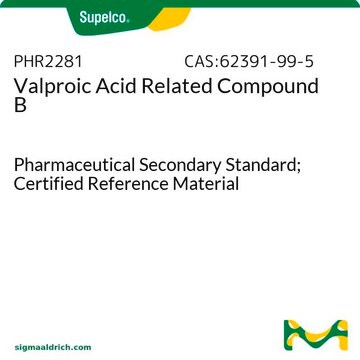1708707
USP
Valproic acid
United States Pharmacopeia (USP) Reference Standard
Sinónimos:
2-Propylpentanoic acid, Valproic acid
About This Item
Productos recomendados
grade
pharmaceutical primary standard
API family
valproic acid
manufacturer/tradename
USP
refractive index
n20/D 1.425 (lit.)
bp
220 °C (lit.)
density
0.9 g/mL at 25 °C (lit.)
application(s)
pharmaceutical (small molecule)
format
neat
SMILES string
CCCC(C(O)=O)CCC
InChI
1S/C8H16O2/c1-3-5-7(6-4-2)8(9)10/h7H,3-6H2,1-2H3,(H,9,10)
InChI key
NIJJYAXOARWZEE-UHFFFAOYSA-N
Gene Information
human ... ALDH5A1(7915)
¿Está buscando productos similares? Visita Guía de comparación de productos
General description
Application
- Divalproex Sodium
- Divalproex Sodium Delayed-Release Capsules
- Divalproex Sodium Delayed-Release Tablets
- Divalproex Sodium Extended-Release Tablets
- Valproate Sodium Injection
- Valproic Acid
- Valproic Acid Capsules
Biochem/physiol Actions
Analysis Note
Other Notes
signalword
Danger
hcodes
Hazard Classifications
Acute Tox. 4 Oral - Eye Dam. 1 - Repr. 1A - Skin Irrit. 2
Storage Class
6.1C - Combustible acute toxic Cat.3 / toxic compounds or compounds which causing chronic effects
wgk_germany
WGK 3
flash_point_f
231.8 °F - closed cup
flash_point_c
111 °C - closed cup
Elija entre una de las versiones más recientes:
Certificados de análisis (COA)
It looks like we've run into a problem, but you can still download Certificates of Analysis from our Documentos section.
Si necesita más asistencia, póngase en contacto con Atención al cliente
¿Ya tiene este producto?
Encuentre la documentación para los productos que ha comprado recientemente en la Biblioteca de documentos.
Nuestro equipo de científicos tiene experiencia en todas las áreas de investigación: Ciencias de la vida, Ciencia de los materiales, Síntesis química, Cromatografía, Analítica y muchas otras.
Póngase en contacto con el Servicio técnico








